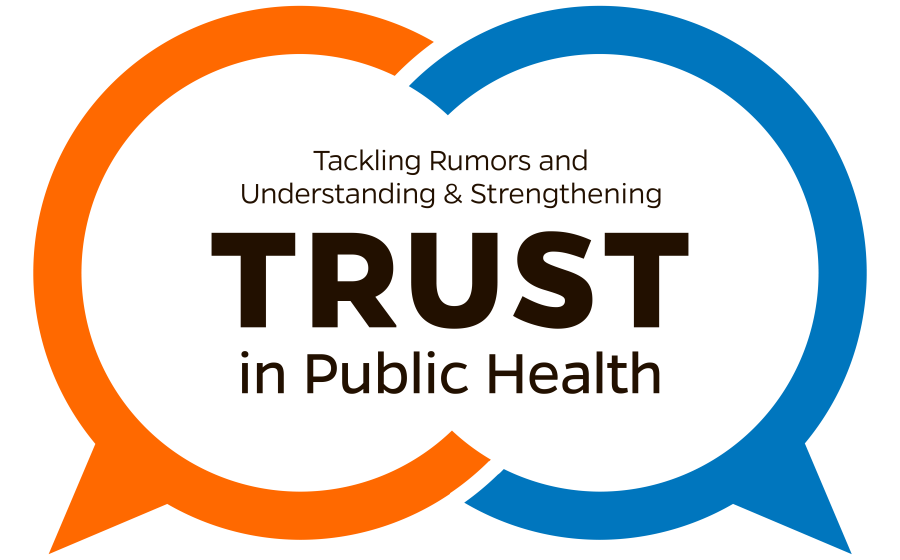
Recommendations for building trust in an environment of rumors and falsehoods
Recommendations
The following recommendations assist public health professionals in increasing or maintaining public trust during health emergencies when misleading claims are abundant. The recommendations are non-exhaustive but represent critical needs in building trust in an environment of rumors and deliberately manipulated information.
1. Anticipate and incorporate strategies to address misleading claims and build trust in public health emergency preparedness and response plans before emergencies arise.
Public health emergencies are inevitable, as are the infodemics that accompany them. Incorporating efforts to anticipate misleading claims into communication strategies by engaging in social listening, prebunking expected rumors, and implementing inoculation activities can help mitigate the harmful effects of such claims on trust and promote health-seeking behaviors. Setting expectations about what public health is and does, as well as building trust through everyday activities, also helps build a foundation of trust that increases community resilience to inaccurate and incorrect claims.
⚙️ Implementation consideration: Practice social listening by building strong connections and consulting with community partners and monitoring social media to identify circulating rumors. Consider leveraging existing social listening tools such as Google Alerts and Talkwalker to strengthen information-tracking efforts on websites, blogs, and social media.
🛠️ Related tools and resources:
2. Address operational and administrative barriers that impact successful communication and trust-building efforts necessary for effective public health emergency response.
Each public health department faces unique internal and external challenges that affect its operational and administrative ability to address misleading claims and engage in trust-building activities. Public health departments that assess their operational and administrative capacities before public health emergencies can prepare a minimum set of core, ready-to-go commitments and actions reflective of their budget, human resources, organizational goals, and political realities. Identify potential gaps in funding preemptively by analyzing past emergency response experiences and curate alternative resources (eg, pool resources with other budgets, partner with third party organizations for cost-effective assistance, etc.) to maintain communication and community engagement activities during health emergencies.
⚙️ Implementation consideration: Increase human resource capacities and maintain community relationships by mitigating threats to workforce retention. Support staff members and limit burnout by implementing a public harassment mitigation system, revising compensation and benefits, and providing opportunities for advancement through training and educational opportunities.
🛠️ Related tools and resources:
3. Build a multidisciplinary communication team that includes individuals who are internal and external to the health department and who represent a variety of lived experiences to reduce response time and improve connections with the community.
“Who do you need in your corner?” Building a coalition of communication and media specialists from health departments, formal and informal secondary messengers, and subject matter experts before health emergencies occur helps communication efforts meet community needs and authentically represent their voices and lived experiences. These relationships and connections can take time to develop and require authentic engagement to flourish. Embedding community partnerships into day-to-day public health activities helps to promote collaboration by increasing 2-way dialogue and face-to-face activities that strengthen trust and contribute to successful health department emergency responses.
⚙️ Implementation consideration: Prioritize sustainability with a far-sighted approach to partnership development that goes beyond public health emergencies. Make plans for how to sustain partnerships once funding pools are exhausted and share outcomes from collaborative communication activities with partners.
🛠️ Related tools and resources:
4. Build resilience to misleading and false rumors, to protect the public against harmful narratives.
Public health departments can prepare communities to adapt to, withstand, and quickly recover from harmful narratives by engaging in efforts to improve health literacy, reducing barriers to factual information, and engaging with formal and informal community partners. Increasing community health literacy and transparency regarding public health decision-making can help mitigate uncertainty and minimize loss of trust as health guidance evolves during emergencies. Public health officials should work with local trusted messengers and leverage community data when it is available to tailor health literacy efforts to community needs. Public health officials must also establish themselves as a trusted and accessible source of information that the public can rely on to stay resilient when faced with harmful narratives.
⚙️ Implementation consideration: Collaborate with community partners to administer educational campaigns, topic-specific training, and other awareness-building opportunities to improve health literacy and establish a presence as a visible, accessible, and trusted source of information.
🛠️ Related tools and resources:
5. Recognize that community trust cannot be assumed; prioritize trustworthiness by engaging authentically with community values and avoiding activities that undermine trust.
Lack of trust in public health departments is a foundational issue that rumors leverage and worsen. Understanding and addressing the root causes of mistrust requires public health departments to build credibility by thoughtfully engaging with high- and low-trust groups, including populations with an adversarial perspective on public health and historically underreached individuals. It also requires public health departments to understand their community’s characteristics, values, and needs by listening to and learning about their history, culture, socioeconomic makeup, and previous experiences with public health departments. Public health’s ability to successfully implement communication approaches to address misleading rumors relies on these consistent and dedicated efforts to build and rebuild trust and create safe spaces for community engagement where individuals may express themselves without fear of judgment and conflict.
⚙️ Implementation consideration: Create consistent lines of communication with community leadership, partners, and the public by designating a health department staff member as a community liaison with the time and resources to conduct trust-building activities. Listen to the community and incorporate their needs and values into public health practices.
🛠️ Related tools and resources:
6. Embrace engaging communication strategies to improve message uptake.
Tailored, visually appealing, accessible, and plain language communication strategies can help capture the public’s attention and successfully frame scientific information to spur positive behavior. Public health departments must leverage these communication strategies and disseminate their messages through multiple forums (social media, local news, radio, etc.) to build trust amongst their audiences and dispel information vacuums in which harmful narratives can flourish. If possible, consult a media specialist within or outside the health department to incorporate messaging into communication strategies to diversify dissemination and increase engagement.
⚙️ Implementation consideration: Identify your audience and communication goals. Developing a robust, consistent, and trustworthy presence on social media is particularly important to reach the under-30 demographic, who access most of their health information on these platforms. Consider connecting health information to topics younger demographics are drawn to in order to increase message engagement and minimize information fatigue.
🛠️ Related tools and resources:
7. Refine and develop new research tools, templates, and strategies to counter misleading claims and measure progress in trust-building and effective messaging.
Efforts to counter misleading rumors and purposefully deceptive narratives have made significant strides in recent years, as shown by the development of novel technologies to support community information tracking. However, gaps remain. Evaluation methods for communication interventions, such as message testing, may be complex and unfeasible given organizational capacities and resources. Evaluation strategies that incorporate community beliefs and needs and that scale up successful individual interventions, such as fact-based, logic-based, and source-based debunking techniques, are needed.
⚙️ Implementation consideration: Continuously practice evaluation processes, including assessing engagement statistics, conducting content analysis, and holding focus groups, to try to determine the impact of risk communication activities and identify areas of improvement.
🛠️ Related tools and resources:
8. Prepare for long-term engagement to build trust and address rumors.
There are no simple or quick fixes to the problems of misleading or harmful rumors and lack of trust. Addressing these issues is a complex endeavor that requires whole-of-community approaches before, during, and after public health emergencies. It requires constant and long-term engagement in a combination of approaches at the information, individual, community, and institutional levels, including but not limited to identifying and filling information voids, enhancing information literacy, engaging with communities, and developing policies/legislation. Public health communicators must commit to long-term efforts to improve trust and address rumors while policymakers ensure consistent funding for those efforts. Successes may be fleeting and progress slow, yet without these investments, public health preparedness and response may be further stymied.
⚙️ Implementation consideration: Escalate community needs into policy discussions by serving as a mediator between communities and the government and advocating for policies that address misleading and deliberately false narratives. The NACCHO Advocacy Toolkit and other resources can help prepare public health professionals to give voice to their community and expertise in a political environment.
🛠️ Related tools and resources:

